Goshawk (Accipiter gentilis)
(1) Where, when and how many?
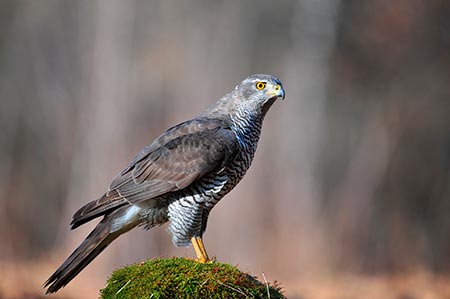
© Urospoteko / https://www.dreamstime.com/
When: Goshawks are present in the New Forest all-the-year-round.
How many: On the Crown Lands of the New Forest - the lands managed by the Forestry Commission, now Forestry England - there were around 40 pairs of Goshawks in the 2019 breeding season.
(2) Goshawks - phantoms of the woods
Goshawks are huge, powerful birds of prey that in the UK were persecuted to extinction by the end of the 19th century but went on to stage a remarkable comeback, kick-started by escaped and deliberately released falconers' birds.
Female Goshawks are almost as big as buzzards, with a wingspan of up to five and a half feet (168 cm), whilst the smaller males still weigh in with a wingspan of four and a half feet (137 cm), or more. Males and females are otherwise of similar appearance - darkish brown-grey above, paler buff below with darker horizontal barring, a fairly prominent white supercilium - a white stripe above the eye, running from near the forehead backwards along the side of the crown - and orange-red eyes.
But separating Goshawks from buzzards and closely related sparrowhawks can sometimes pose problems. Goshawks, however, have a smaller, more protruding head than buzzards, shorter wings and a much longer tail; whilst, although some male Goshawks are not too much bigger than large female sparrowhawks, size - including the Goshawk's broader, deeper, bulkier chest - helps distinguish Goshawks from sparrowhawks, although lots of practise and access to a good field guide will clearly be useful.
The Goshawk's frequently relaxed flight pattern is distinctive, but again similar to that of the sparrowhawk, and can best be described as a series of flaps followed by a glide, endlessly repeated. Broad wings and long tail, however, enable fast acceleration and remarkable manoeuvrability when chasing down prey amongst the trees at speeds of up to 25 miles (40 km) per hour.
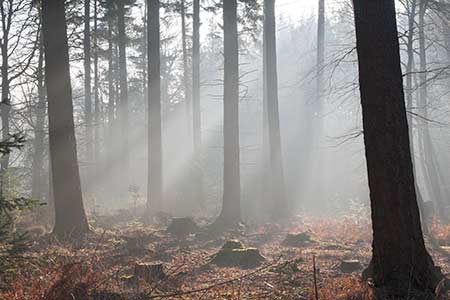
The Goshawk is primarily a woodland inhabitant that frequently evades observation by sitting still, high in the canopy. Indeed, so secretive, so elusive, so difficult to spot are these huge birds of prey that they are sometimes known as the 'phantoms of the woods'. However, the loud kya-kya-kya-kya calls of the female, in particular, may be heard during the breeding season, especially early in the day, and what has been described as 'high circling' - soaring on outstretched wings - can be seen at almost any time of year.
But mainly in late winter and early spring, members of the modest-sized but increasingly successful New Forest Goshawk population become relatively conspicuous, for that is when they engage in spectacular aerial displays. Look out, for example, for 'sky dancing', a series of manoeuvres during which the birds soar upwards in tight spirals before plunging headlong, down into the breeding woods.
(3) Diet
Goshawks are fierce, highly skilled predators that take a range of birds, and mammals such as rabbits and grey squirrels. Avian prey in woodland is chased through the trees or taken whilst stationary - perched on a branch, on the ground or even on a nest. Goshawks will also hunt over open ground but only when this is close to their favoured woodland haunts.
Any bird species of suitable size will be hunted down. Wood pigeons certainly make a good meal for a Goshawk, stock doves are no doubt regularly caught and so, too, are corvids - for example, carrion crows, rooks, jackdaws and jays. Certainly, no bird is safe when a Goshawk is around, including New Forest favourites such as green woodpeckers and great spotted woodpeckers. Perhaps more surprisingly, though, Goshawks will also take smaller birds of prey, such as hobbies, although to what extent is uncertain.
(Rob Clements, Simon Currie, Richard Jacobs and Andy Page - The Hobby in Hampshire: Hampshire Bird Report 2016 - reported a significant decline in successful breeding attempts by New Forest hobbies, and also a decline in the presence of breeding sparrowhawks, as Goshawk numbers increased. Competition for nest sites may, in part, be responsible but so, too, may predation by Goshawks of the smaller birds of prey - in 2014, for example, a hobby fledgling was seen being taken from the nest by a Goshawk).
Conspicuous prey remains - for example, scattered wood pigeon feathers or bits of a rabbit - can sometimes be seen on the woodland floor or on a tree stump, a reminder that a Goshawk, sparrowhawk or other predator has enjoyed a meal.

(4) Breeding and dispersal
For many observers, the highlight of the Goshawk breeding season is the late-winter / early spring displays above the canopy as territories are established or re-established, and pair bonds formed.
The large, untidy nest, which may sometimes be strengthened and re-used in subsequent years, is usually situated high up in the branches of a tall tree - often a conifer - and may well be virtually invisible from the ground.
Eggs are laid in around the first half of April, the typical clutch size is 3 - 4 eggs, incubation is 35 - 38 days and the fledging period is 35 - 42 days. Breeding season-related activities, then, last for 6 months, or more, each year.
Female Goshawks apparently remain near the breeding territory all-the-year-round, whilst males may wander a little more widely but are never-the-less also considered to be essentially sedentary.
A peek into the private lives of New Forest Goshawks at the nest is available via images from a Nestcam - fascinating historical footage is shown below, courtesy of the New Forest National Park Authority.
A 2023 Webcam is also available, courtesy of Forestry England.
(5) The Goshawk - a bird that came back from extinction in the UK
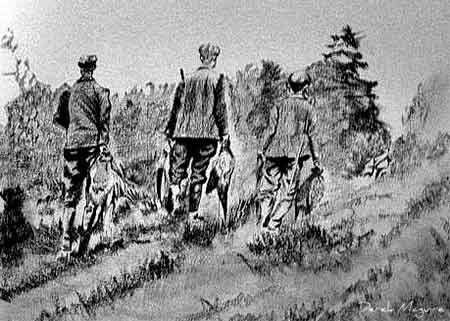
© Derek Maguire / Attribution-NoDerivs 2.0 Generic (CC BY-ND 2.0)
Goshawks are birds of mystery, rarely seen creatures that live deep in the woods. Their early breeding status in the UK is also shrouded in a certain amount of mystery, not least because in some parts of the country they were known as peregrines; whilst the precise origin of current breeding populations is also far from certain.
It is possible, however, to piece together elements of the story.
Goshawks in the 19th and early 20th centuries
Goshawks are thought to have become extinct in Britain as breeding birds during the later years of the 19th century and had become extremely scarce at least a century earlier, victims of deforestation and persecution.
In the mid-19th century, John Wise, chronicler of life in the New Forest, included an entry for Goshawk that is short and to the point, and reflects both the bird's scarcity at that time and also the perils faced by many wild birds in Victorian England. He simply said: 'Sometimes a stray bird is killed'. Yes, very short and to the point, indeed.
A little later in the same century, Gerald Lascelles, Deputy Surveyor of the New Forest from 1880 until 1914 and a keen falconer, makes no reference at all to Goshawks in the New Forest when recollecting his time in the area; whilst the Reverend J.E. Kelsall and Philip W. Munn (The Birds of Hampshire and the Isle of Wight, 1905) noted: 'We do not think there is sufficient evidence to include this bird in our list'.
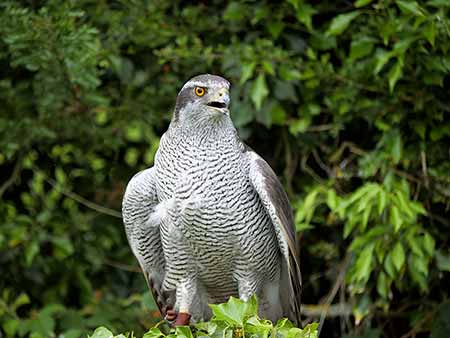
© David Dixon / Attribution-ShareAlike 2.0 Generic (CC BY-SA 2.0)
The 20th century - escaped and released Goshawks re-establish a population in the wild
Subsequently, Edwin Cohen and John Taverner (A Revised List of Hampshire and Isle of Wight Birds, 1972) stated that the first Hampshire record of the species in the 20th century was of one soaring over Sloden Inclosure, in the New Forest, in June 1938. The only other New Forest records mentioned were of one near Fordingbridge in 1953 and again in 1957.
The authors went on to comment, however, that: 'Unfortunately, the species is imported in some numbers by falconers, who not infrequently lose them, so that one can seldom rule out the possibility of a bird being an escape'.
In the Atlas of Breeding Birds in Britain and Ireland (1976), though, it was noted that: 'A tiny pocket of up to three pairs bred in Sussex from at least 1938 (possibly as early as 1921) until 1951' and went on to say that: 'During much of this time, their existence was known only to falconers ...', which implies that this population owed its existence to the deliberate release or escape of falconers' birds, freed so that the young could later be taken from the nest.
After 1951, there were a number of other UK nesting records up to 1967, and then during 1968 - 72, regular breeding in Britain was discovered during fieldwork associated with the 1976 Atlas, although none of the breeding sites were in the south of England.
Natural recolonisation up to that time was, however, considered unlikely as Goshawks rarely disperse far from their natal sites, again implying the likelihood of deliberate or accidental releases.
As for the later 1970s, Simon Holloway in The Historical Atlas of Breeding Birds in Britain and Ireland 1875 - 1900, published in 1996, stated that: '...the population proliferated in the 1970s, a period during which large numbers of birds were imported and many released', although the theft of eggs and young by egg collectors and hawk keepers apparently significantly reduced the rate of increase.
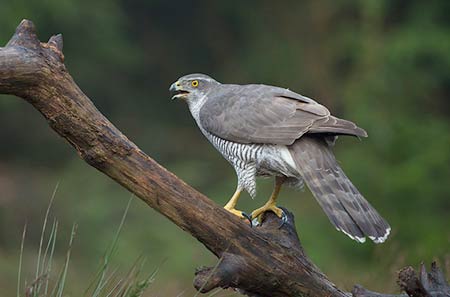
© Martha de Jong-Lantink / Attribution-NonCommercial-NoDerivs 2.0 Generic (CC BY-NC-ND 2.0)
Mick Marquiss in The New Atlas of Breeding Birds in Britain and Ireland: 1988 - 1991, noted that: '...by 1980 there were records of about 60 pairs, including 39 active nests', whilst the associated distribution map showed an increasing spread of records, including within the New Forest, although confirmed breeding was then unknown in Hampshire.
Furthermore, it was estimated that in 1988, there were around 200 pairs in Britain, although it was pointed out that 'Goshawks are not easily counted...and that problems of disturbance, egg robbing and persecution have engendered secrecy', suggesting that pre-1988 population estimates and distribution maps may have been inaccurate.
It was also reiterated in The New Atlas that: 'The British Goshawks were largely, if not wholly, derived from imported birds which escaped from hawk keepers or were deliberately released' and went so far as to say: 'The Goshawks which started breeding in the mid-1960s were mainly small birds from Central Europe, whereas those established in the early 1970s were much larger and paler birds, mainly from Finland (Marquiss 1981).
Goshawks as breeding birds in the New Forest
But from whatever source, Goshawks were found to be breeding in the New Forest in 2002, and since that time numbers have considerably increased. Indeed, it was reported in the Hampshire Bird Atlas 2007 - 2012 that: '...one New Forest 10 km square contained fourteen occupied sites during 2012. Eleven of these held breeding pairs and the other three, territory holding singles'.
Twenty-nine pairs were present in total in the 2012 breeding season, whilst by 2019 this number had increased to around 40 pairs.
References:
A Revised List of Hampshire and Isle of Wight Birds: Edwin Cohen and John Taverner
The Atlas of Breeding Birds in Britain and Ireland: J.T.R. Sharrock
The New Atlas of Breeding Birds in Britain and Ireland: 1988-1991: David Wingfield Gibbons, James B. Reid, Robert A. Chapman
The Historical Atlas of Breeding Birds in Britain and Ireland 1875-1900: Simon Holloway
Hampshire Bird Atlas 2007-12: edited by John Eyre
Hampshire Bird Reports: 2016
Collins Bird Guide: Mullarney, Svensson, ZetterstrÖm and Grant
Handbook of the Birds of Europe, the Middle East and North Africa, The Birds of the Western Palearctic (volumes 1-9): Stanley Cramp, et al
Quick links
More links
Search this site

